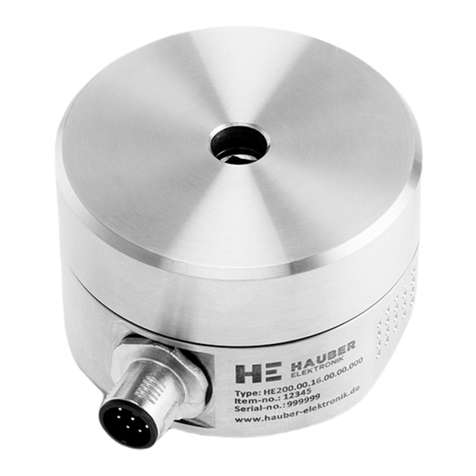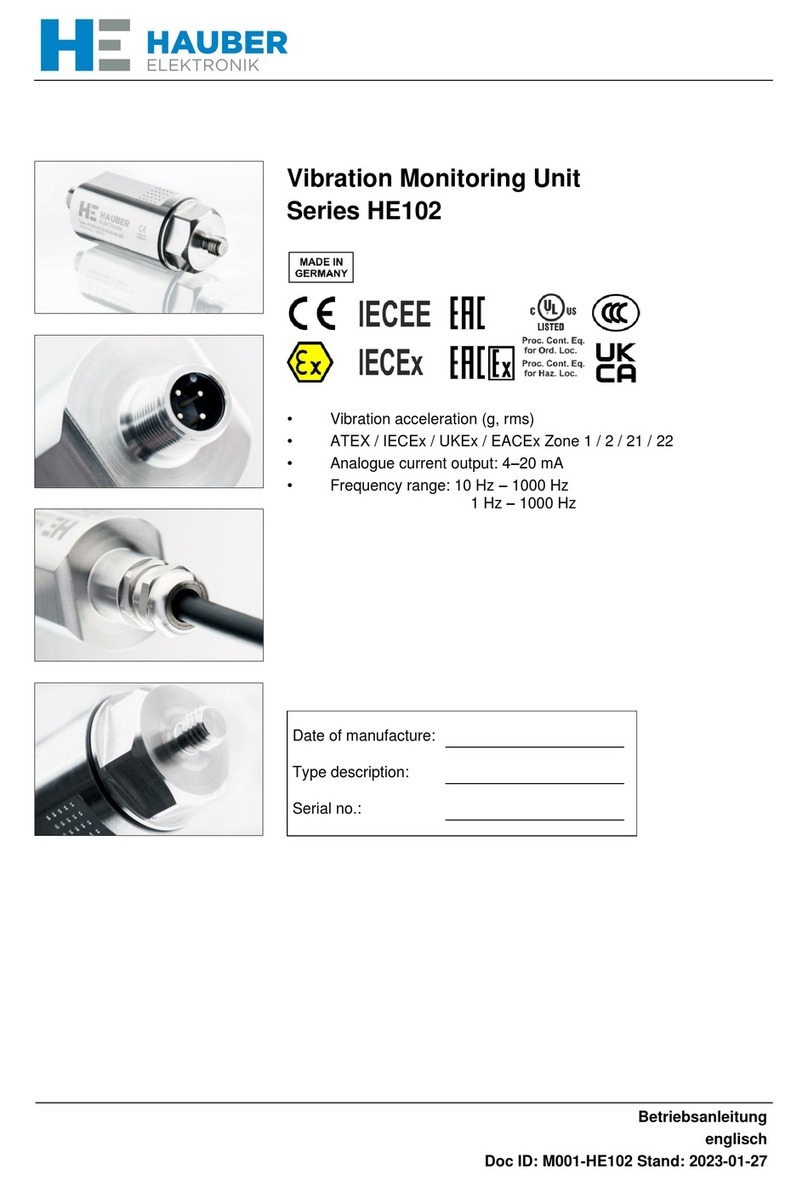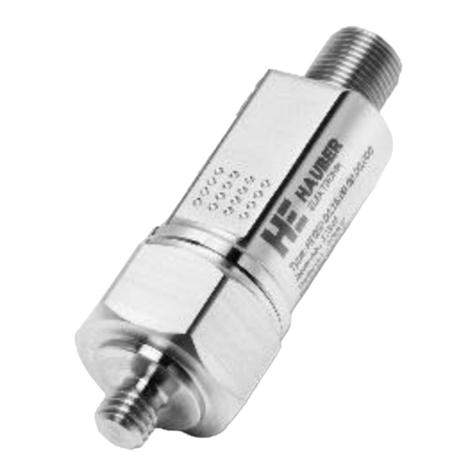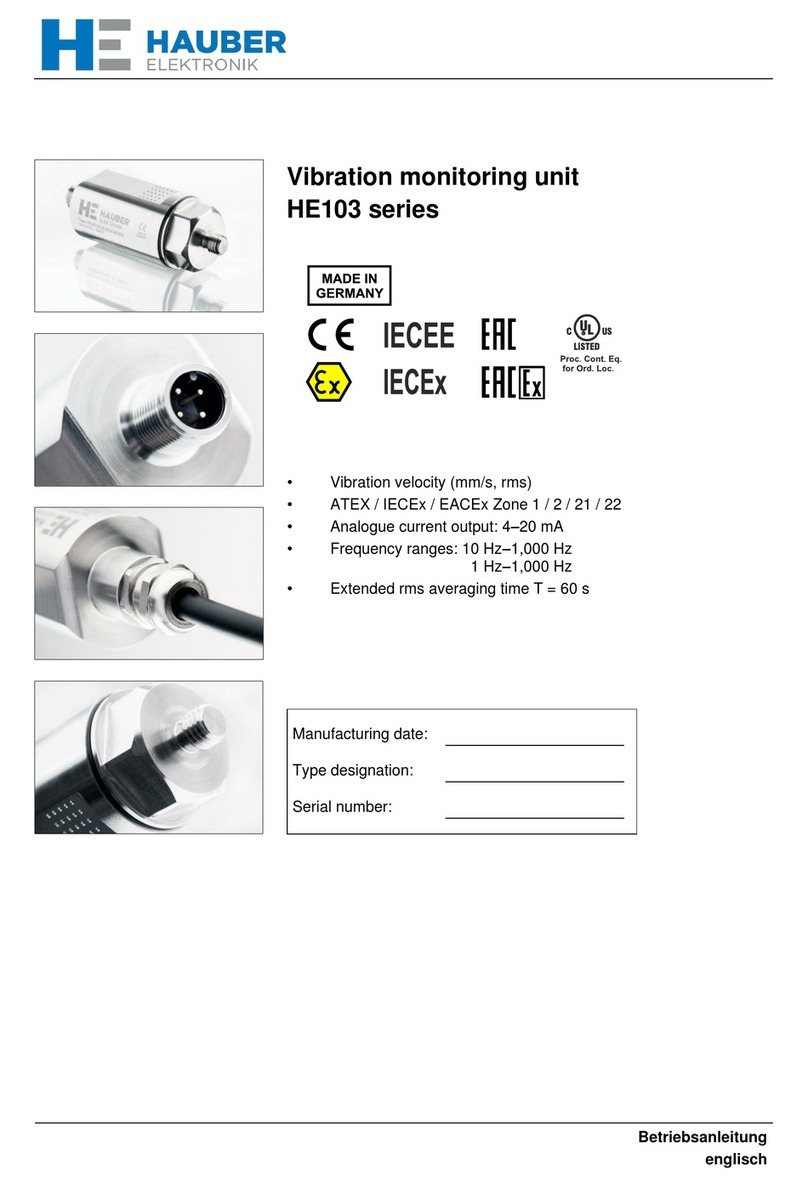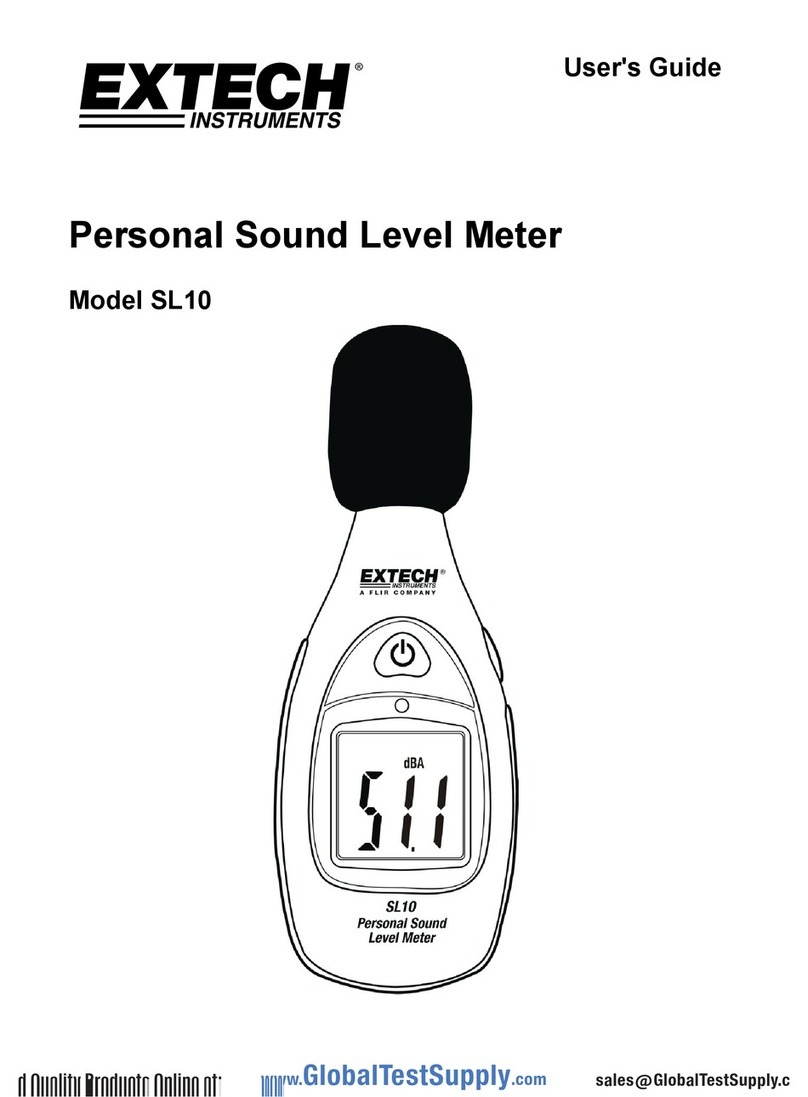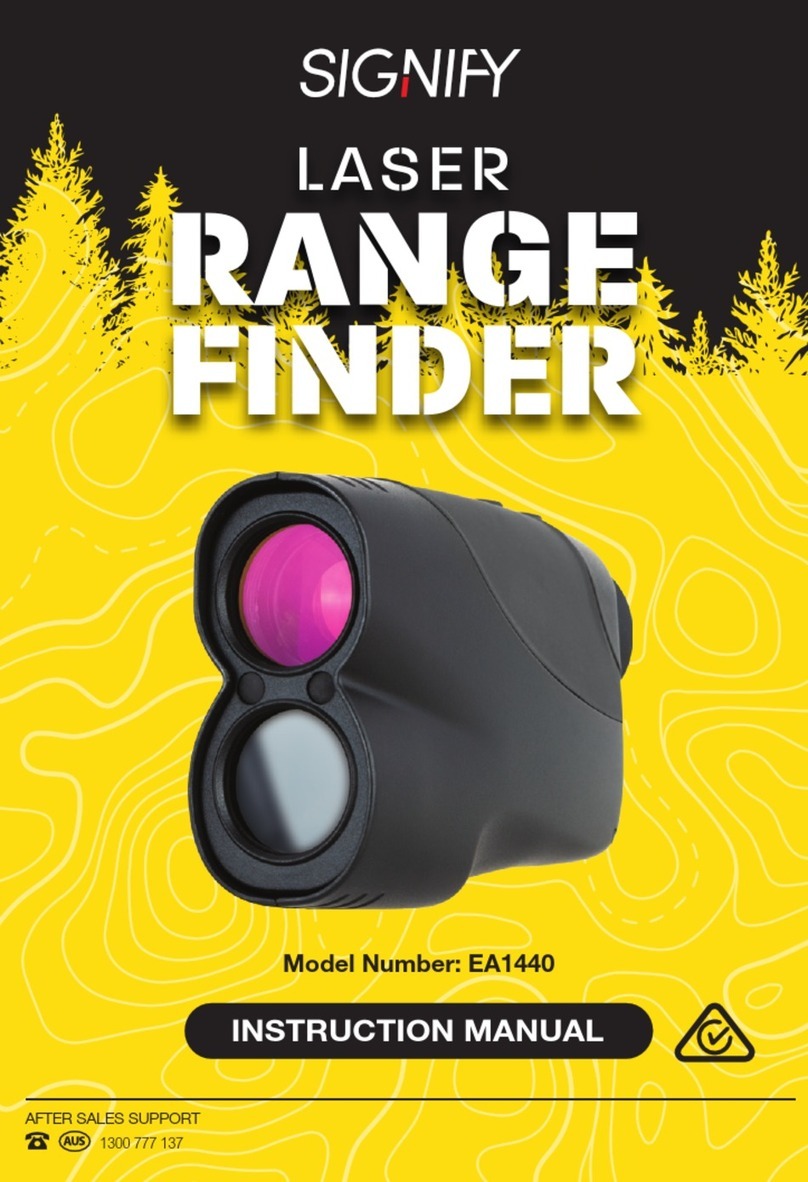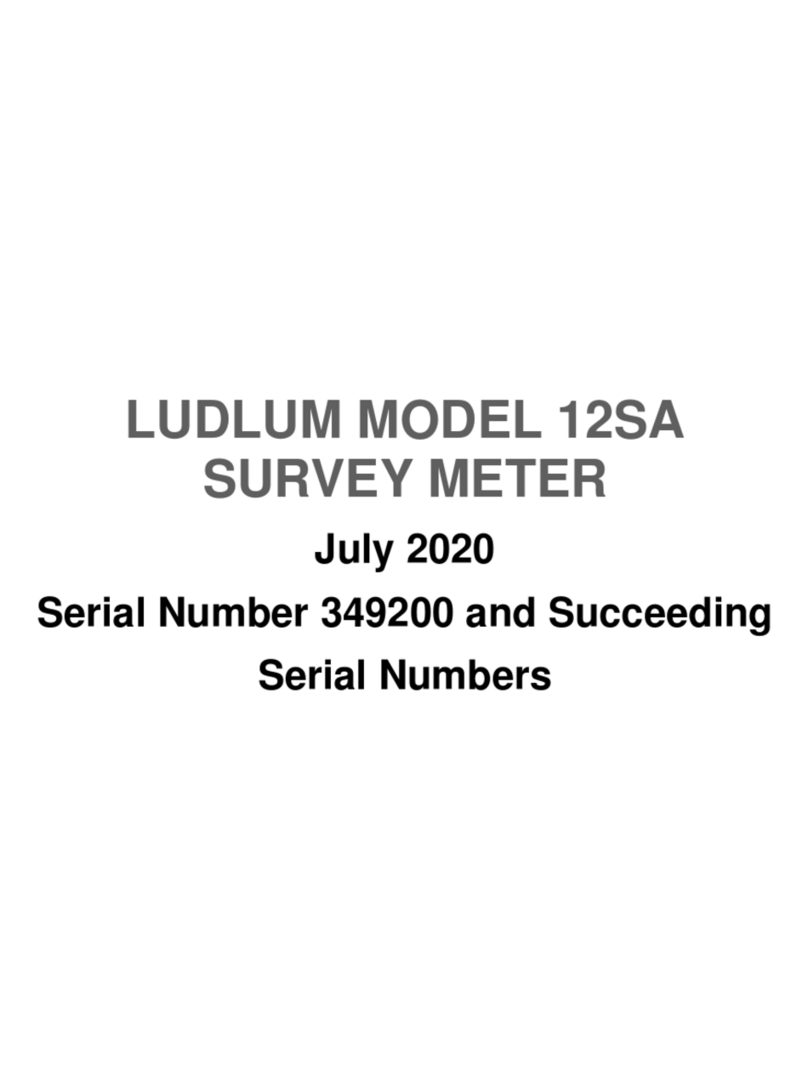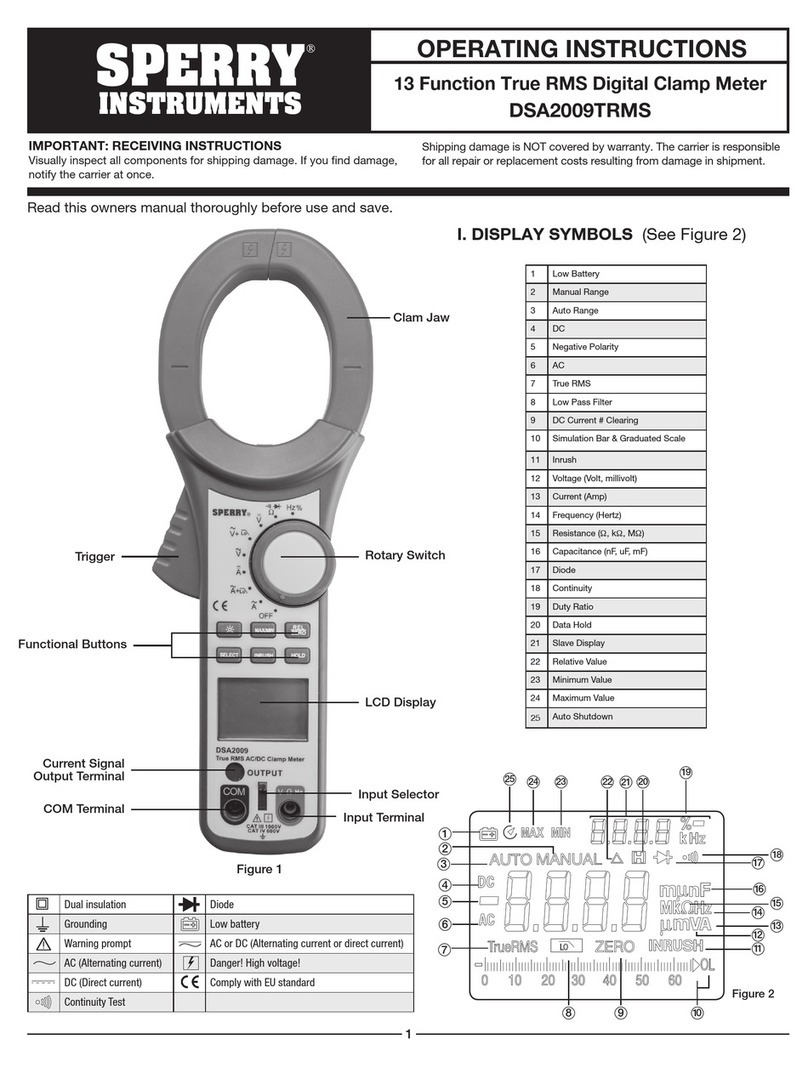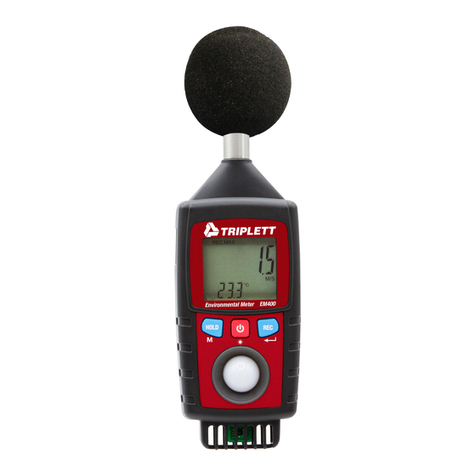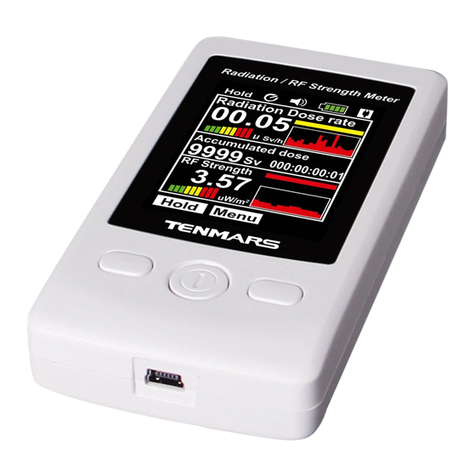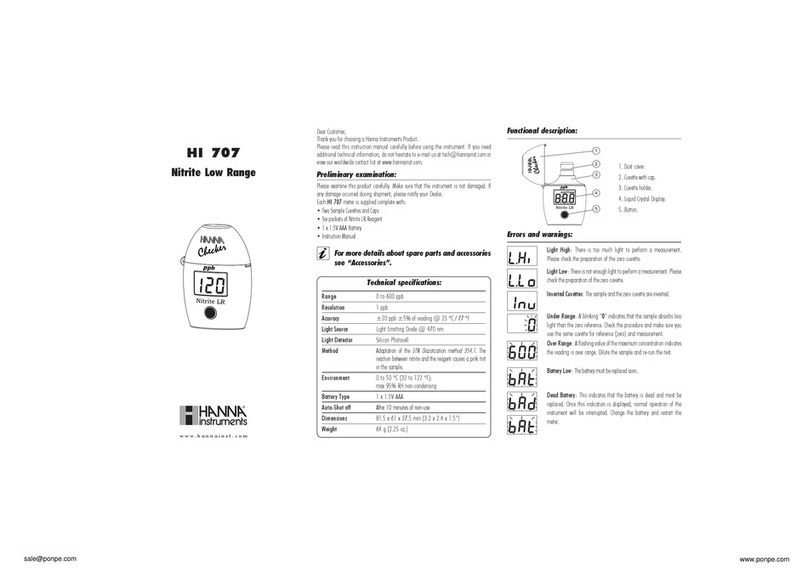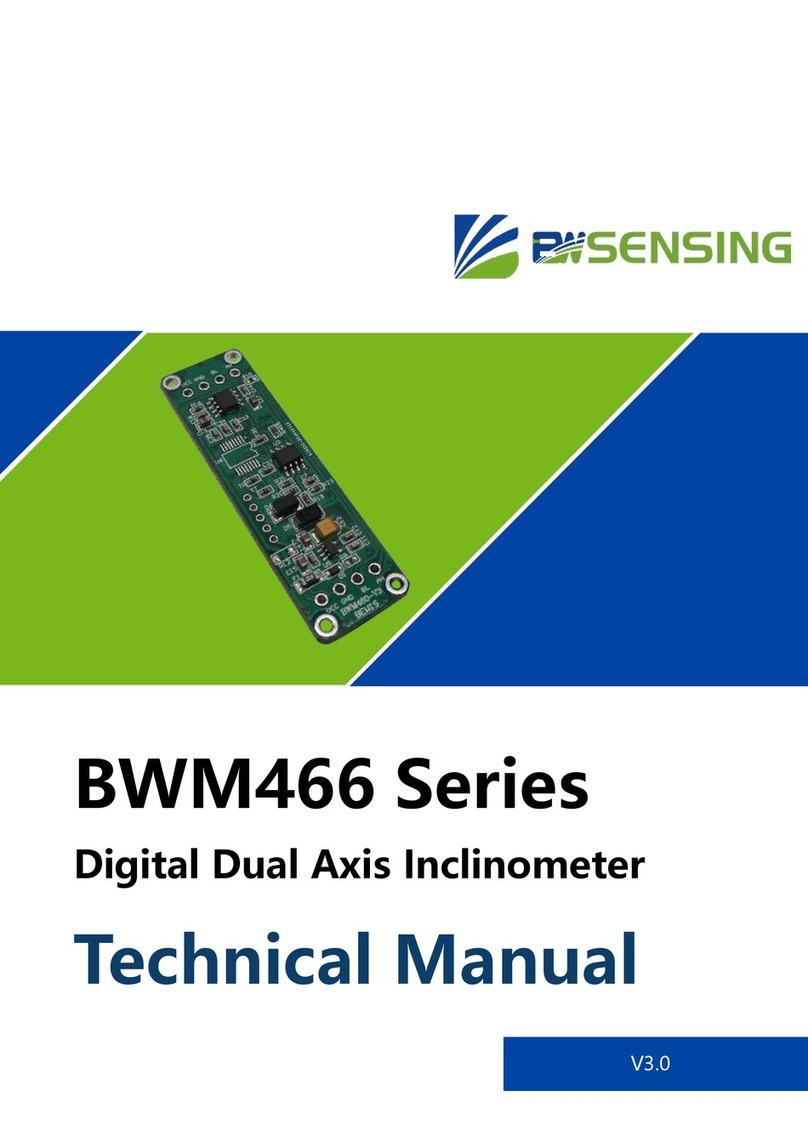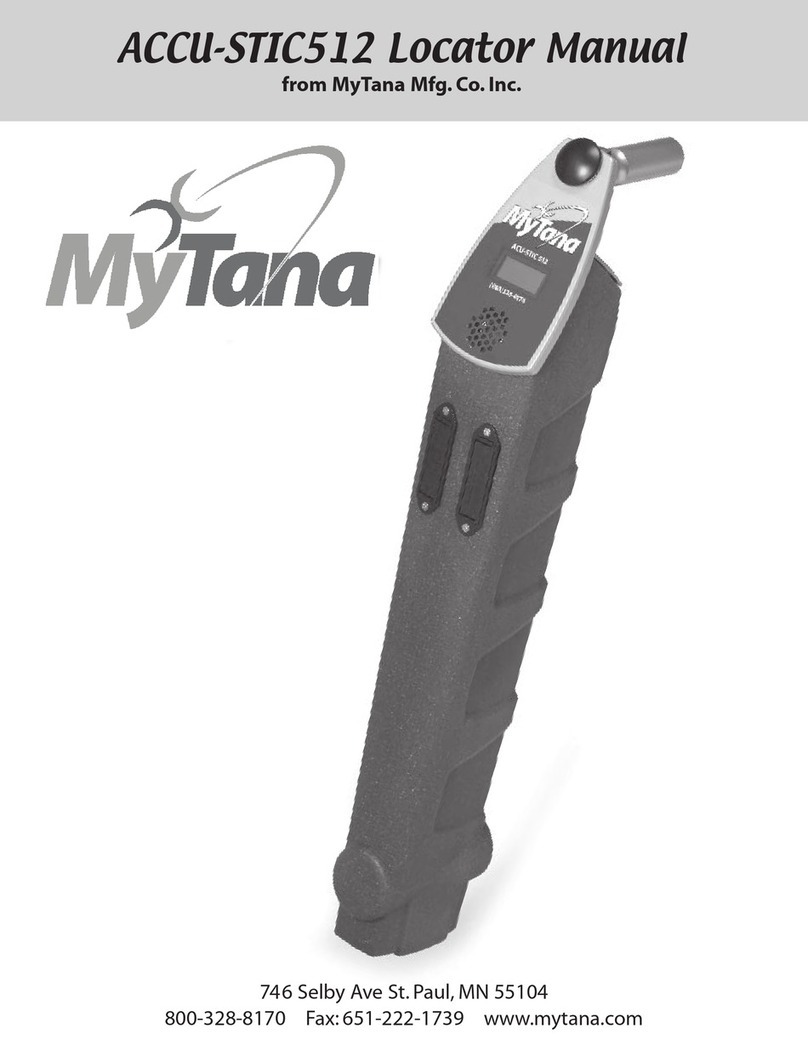Hauber 663-Window User manual

Betriebsanleitung
englisch
Doc ID: M001-663-Window Stand: 2021-03-29
Vibration Control
Type 663-Window
•Vibration acceleration (g, peak)
•2 Relay-switching outputs (Adjustable)
•Analogue current output: 4…20 mA
•Frequency range: 10 Hz … 1000 Hz
1 Hz … 1000 Hz
Date of manufacture:
Type description:
Serial no.:

HAUBER-Elektronik GmbH
Operating instructions
Vibration Monitoring Unit
Type 663-Window
Standard
Zone 2 / 22
Zone 1 / 21
663-Window
Version: 2021-03-29
Attention!
Prior to commissioning the product, the instruction manual must be read and un-
derstood.
All rights reserved, including rights to translation.
Subject to modifications.
Please contact the company with any questions:
HAUBER-Elektronik GmbH
Fabrikstraße 6
D-72622 Nürtingen
Germany
Tel.: +49 (0) 7022 / 21750-0
Fax: +49 (0) 7022 / 21750-50
info@hauber-elektronik.de
www.hauber-elektronik.de

HAUBER-Elektronik GmbH
3
1Safety information....................................................................................................................................4
2Instruction Manual Scope ........................................................................................................................5
3Vibration Control Type 663-Window........................................................................................................5
4Intended Use............................................................................................................................................5
5Safety Level .............................................................................................................................................5
6Documents and Certificates.....................................................................................................................6
7Transfer of liability when operating in potentially explosive atmospheres...............................................6
8Fields of application.................................................................................................................................6
9Scope of supply .......................................................................................................................................6
10 Technical data..........................................................................................................................................7
10.1 General data.........................................................................................................................................7
10.2 Electrical data .......................................................................................................................................7
10.3 Typical frequency response..................................................................................................................8
10.4 Mechanical data....................................................................................................................................9
10.5 Housing dimensions..............................................................................................................................9
11 Connections...........................................................................................................................................10
12 Functional Description ...........................................................................................................................11
12.1 Operating Conditions..........................................................................................................................12
12.2 Limit values.........................................................................................................................................12
12.3 Self test...............................................................................................................................................13
13 Assembly and disassembly....................................................................................................................13
13.1 General notes .....................................................................................................................................13
13.2 Fixing the vibration monitoring unit to the mounting surface..............................................................14
13.3 Zone 2 /22 - Fastening Safety Clip / Protective Cover .......................................................................15
13.4 Tamper protection...............................................................................................................................16
14 Installation and Commissioning.............................................................................................................16
15 Grounding Concepts to Avoid Ground Loops........................................................................................16
15.1 Standard Grounding Concept.............................................................................................................17
15.2 Alternative grounding concept............................................................................................................17
16 Maintenance and repair.........................................................................................................................18
16.1 General notes .....................................................................................................................................18
16.2 Troubleshooting Table........................................................................................................................18
17 Coding....................................................................................................................................................19

HAUBER-Elektronik GmbH
4
1 Safety information
1.1 General
The safety instructions are intended to protect people and property from damage and hazards
that could arise as the result of improper use, incorrect operation or other misuse or devices,
especially in explosive areas. Therefore, please read the operating instructions carefully before
working on the product or operating it. The operating instructions must be accessible to operat-
ing personnel at all times.
Please make sure that all documents are present and complete before commissioning or per-
forming other work on the product. If the documents have not all been delivered in full or if fur-
ther copies are necessary, they can also be obtained in other languages.
The product is built according to the latest state of the art. However, hazards to people, machin-
ery and systems can still arise as the result of improper handling, unintended use or operation
and maintenance by persons inadequately trained on the product.
All those who are involved in the installation, operation and maintenance of the product in the
operator’s plant must read and understand the operating instructions.
The product may only be assembled, disassembled, installed and repaired by instructed, suffi-
ciently trained and authorised personnel.
1.2 Symbols used
This symbol indicates an explosion hazard.
This symbol indicates a hazard from electrical current.
This symbol indicates information unrelated to safety.

HAUBER-Elektronik GmbH
5
2 Instruction Manual Scope
The present instruction manual of Vibration Control Type 663-Window is applicable for the mod-
els: Standard, Zone 1 / 21 and Zone 2 / 22.
The functionality of these models is identical. In addition, they have certifications and labellings
allowing their operation in potentially explosive atmospheres. See also Fields of application,
page 6.
3 Vibration Control Type 663-Window
Vibration Control Type 663-Window is used for measuring and monitoring the bearing vibration
of machines as per DIN ISO 10816. It offers the following features:
•Two limit values and two associated delays are seperately adjustable.
•Both relay-switching outputs indicate an exceeding of resp. a fall below the adjusted win-
dowrange. This can be used to genarate an alarm.
•Measurement parameter: The peak value of the vibration acceleration. (1 g = 9.81 m/s²)
•Analogue current output: Interference-free direct current from 4...20 mA, proportional to
the vibration amplitude.
•Cable break on the control cable can be detected by a succeeding evaluation device:
Value of the direct current signal < 3.5 mA.
4 Intended Use
Type 663-Window is used to protect machines and mechanical equipment against undue me-
chanical vibrations. Its use is only allowed within the specifications as per the data sheet, and
exclusively for measuring mechanical vibrations. Main areas of application: Conveyor and
sieving equipment, drying and cooling systems and similar oscillating mechanical plants and
equipment.
5 Safety Level
The hardware, vibration control Type 663-Window, was tested using Exida's FMEDA. The re-
sults of the FMEDA meet the criteria according to SIL2, SIL3 and PL-d.
In determining the safety function, using the safety key figures in accordance with the standards
mentioned under item 4 in the safety manual, the relay contacts of the vibration control Type
663-Window were explicitly evaluated and taken into account. The current output 4...20 mA is
not configured in a safety-relevant manner.
For more information, refer to the safety manual.

HAUBER-Elektronik GmbH
6
6 Documents and Certificates
Please see www.hauber-elektronik.de for the following documents and certificates for Type 663-
Window:
•EC Declaration of Conformity
•Safety manual SIL2
•Safety manual SIL3
•Declaration of conformity ATEX zones 2 and 22, no.: LU 15 ATEX 0131X
•EC-type examination certificate ATEX zones 1 and 21, no.: SNCH 09 ATEX 4380
7 Transfer of liability when operating in potentially explosive atmospheres
The owner of the system is exclusively liable for the appropriate configuration of the electrical
connections with respect to explosion protection regulations and correct commissioning.
If the system is installed by a sub-contractor on behalf of the owner, the system may only be
commissioned after the sub-contractor has issued written confirmation in the form of a certificate
of installation that the system has been installed correctly and professionally in accordance with
the applicable legal regulations.
The operator is obliged to notify the responsible authorities of the initial commissioning of explo-
sion-protected systems or system components and their re-commissioning following extensive
changes or maintenance.
8 Fields of application
Model
Application Fields
Labelling
Standard
Non-explosive atmospheres
Zone 1 / 21
Potentially explosive atmos-
pheres, zone 1 and 21
II 2 G Ex d IIC T4 Gb
II 2 D Ex tb IIIC T120 °C Db
Zone 2 / 22
Potentially explosive atmos-
pheres, zone 2 and 22
II 3 G Ex d nA IIC T4 Gc
II 3 D Ex tc IIIC T120 °C Dc
Tab. 1: Application fields
9 Scope of supply
All versions include:
•Vibration monitoring
•Cylinder head screw with hex socket, M8 x 20 mm
•Spring washers for M8
•Seal label
•Operating instructions
Version Zone 2 / 22 further includes:
•Protective cover for M12 connector
•Safety clip

HAUBER-Elektronik GmbH
7
10 Technical data
10.1 General data
Each sensor has one of the listed measuring and frequency ranges. Further
ranges on request.
Please indicate the measuring and frequency range in your request.
Measuring range:
0 … 4 g
0 … 6 g
0 … 6.4 g
0 … 12 g
Measuring accuracy:
± 5%
Transverse sensitivity:
< 5%
Frequency range:
10 Hz … 1000 Hz (standard)
1 Hz … 1000 Hz
Temperature range:
Ambient temperature:
-30 °C…+60 °C
Measuring head temperature:
-30 °C…+85 °C
Tab. 2: General data
10.2 Electrical data
Output signal:
1 x 4-20 mA (proportional to the measuring range)
Switching contact:
2 x relay contact (pre- and main alarm)
Switching contact switching
load:
1A / 30 V DC
Power supply:
24 V DC ± 10%
Power input (max.):
80 mA
Load/output load (max.):
500 Ω
Fusing:
Microfuse (medium time lag, 160 mA, breaking capacity C)
Automatic:
As soon as the vibration values fall below the limit values, the
potential-free switching contacts automatically re-energize.
Tab. 3: Electrical data
Only unscrew the housing cover if Type 663-Window is disconnected from the mains or
if the atmosphere is non-explosive Otherwise, there is an explosion hazard from spark-
ing when operating ATEX-certified Type 663-Window in potentially explosive atmos-
pheres!
Prior to commissioning Type 663-Window, protect the mains using a microfuse (me-
dium time lag, 160 mA, breaking capacity C)!

HAUBER-Elektronik GmbH
8
10.3 Typical frequency response
10 Hz–1,000 Hz (standard)
The frequency response is recorded using a reference sensor.
• 4 Hz. . . 1200 Hz acceleration sensor
Fig. 1: Typical frequency response 10 Hz–1000 Hz
1 Frequency in Hz
2 Amplification in dB
1 Hz–1000 Hz
The frequency response is recorded using two reference sensors.
• 1 Hz. . . 10 Hz laser sensor
• 10 Hz. . . 1200 Hz acceleration sensor
Fig. 2: Typical frequency response 1 Hz–1000 Hz
1 Frequency in Hz
2 Amplification in dB

HAUBER-Elektronik GmbH
9
10.4 Mechanical data
Housing material:
Stainless steel V2A, material no.: 1.4305 (standard)
M12 connector material:
CuZn (brass), nickel plated
Cable gland:
V2A stainless steel
Fastening:
Cylinder head Allen screw M8 x 20 mm
Thread pitch: 1.25 mm (standard)
Mounting:
Housing must be earthed via the M8 fastening
Weight:
approx. 500 g
Protection class:
IP 67
Tab. 4: Mechanical data
10.5 Housing dimensions
Fig. 3: Housing with M12 connector
Fig. 4: Housing with in-
tegrated cable
All measurements
in mm
1 M12 connector
2 Measuring direction
1 Connecting cable
2 Cable gland
3 Measuring direction

HAUBER-Elektronik GmbH
10
11 Connections
Variant:
M12 connector (Standard, Zone 2 / 22)
Pin 1:
24 V DC
Pin 2:
GND
Pin 3:
4 … 20 mA current signal
Pin 4:
Self test (+24 V)
Pin 5:
Relay 1
Pin 6:
Relay 1
Pin 7:
Relay 2
Pin 8:
Relay 2
Variant:
Integrated cable (Zone 1 / 21)
Pin 1:
Weiß
24 V DC
Pin 2:
Braun
GND
Pin 3:
Grün
4 … 20 mA current signal
Pin 4:
Gelb
Self test (+24 V)
Pin 5:
Grau
Relay 1
Pin 6:
Rosa
Relay 1
Pin 7:
Blau
Relay 2
Pin 8:
Rot
Relay 2
Connection plan:
Fig. 5: Connection plan
1 Relay 1
2 Relay 2
3 Evaluation unit (amperemeter, PLC, …)
4 Self-check switch
The connection plan shows the alarm condition and/or the currentless condi-
tion! Relay 1 and 2 are dropped out.

HAUBER-Elektronik GmbH
11
12 Functional Description
Only unscrew the housing cover if Type 663-Window is disconnected from the
mains or if the atmosphere is non-explosive. Otherwise, there is an explosion
hazard from sparking when operating ATEX-certified Type 663-Window in po-
tentially explosive atmospheres!!
Type 663-Window has two limit values, LIM1 and LIM2, with their respective lag times, which
can all be adjusted separately. If the value of the acceleration is below or above an adjustable
window-range, an alarm is generated. The lower limit of the window-range will be adjusted with
LIM1 and the upper limit with LIM2
In addition, Type 663-Window has an analogue current output. This delivers a direct current of
4...20 mA proportional to the vibration acceleration.
Fig. 6: User Interface Channels LIM1 and LIM2
1 SET Turn-Switch (Limit Value in 15 Steps)
2 TIME-Potentiometer (Lag Time Variably Adjustable, 0...30 sec.)
3 LED Indicators
Fig. 7: Window function
1 Alarm for values below LIM1
2 Window area
3 Alarm for values above LIM2

HAUBER-Elektronik GmbH
12
12.1 Operating Conditions
Operating Condition
Measurement
Relay
LED Indicator
OK
Within Limit Values
Energised
OK
WARNING
Outside of Limit Values,
Lag Time Running
Energised
WARNING + OK
ALARM
Outside of Limit Values,
Lag Time Expired
Dropped out
ALARM
Tab. 5: Operating Conditions
12.2 Limit values
SET Position
Limit values (mm/s)
Measuring range
0 … 4 g
0 … 6 g
0 … 6,4 g
0 … 12 g
0
0
0
0
0
1
0,25
0,375
0,4
0,75
2
0,5
0,75
0,8
1,5
3
0,75
1,125
1,2
2,25
4
1
1,5
1,6
3
5
1,25
1,875
2
3,75
6
1,5
2,25
2,4
4,5
7
1,75
2,625
2,8
5,25
8
2
3
3,2
6
9
2,25
3,375
3,6
6,75
10
2,5
3,75
4
7,5
11
2,75
4,125
4,4
8,25
12
3
4,5
4,8
9
13
3,25
4,875
5,2
9,75
14
3,5
5,25
5,6
10,5
15
3,75
5,625
6
11,25
Tab. 6: Limit values
The SET rotary button has 16 positions, representing the limit value of an alarm. The measur-
ing range of the vibration monitoring unit is divided into 16 linear steps.
In general:
Example: Limit setting
Measuring range:
0 … 6 g
SET rotary button Pos.:
8
Limit value:
3 g

HAUBER-Elektronik GmbH
13
12.3 Self test
The self-test is to verify the correct functioning of the vibration control. Therefore, a test signal is
applied to pin 4 of the control. The test signal simulates a vibration amplitude exceeding the
maximum limit value. This will trigger the control's alarm condition.
Test signal:
a. Direct current, 24 V DC or
b. Square wave signal, 24 V DC / 0.5 Hz
Initial state:
Normal operation
Self-test start:
•Apply the test signal to pin 4.
•The output current signal increases up to ~23 mA.
•After < 35 s, the alarm relays drop out.
If one or both alarm relays fail to drop out, this indicates a fault.
•Remove the test signal.
•After a further < 60 s the output current signal has re-
turned to to 4 mA or its actual value
End self test
Final state:
Normal operation
Duration:
approx. 95 s
Test signal a is only available for production no. 75478 or later.
13 Assembly and disassembly
13.1 General notes
Assembly and disassembly work on and with the monitoring unit may only be performed by an
authorised specialist familiar with the safety regulations governing handling electrical compo-
nents! When using EX-certified monitoring units in potentially explosive atmospheres, the pro-
fessional must also be familiar with the relevant safety regulations!
Before assembly and disassembly disconnect the monitoring unit from the power sup-
ply! Separate plug connections must always be de-energized! If EX-certified monitoring
is operated in a potentially explosive atmosphere, there is otherwise an explosion haz-
ard, due to spark formation!
The monitoring unit housing must be earthed via the fastening - through the
machine earth of the mounting surface or through a separate protective conductor (PE)!

HAUBER-Elektronik GmbH
14
13.2 Fixing the vibration monitoring unit to the mounting surface
Prerequisites
• Mounting surface is clean and flat; i.e. free of
paint, rust, etc.
• Threaded hole in mounting surface:
15 mm, M8
Tools and material
•Hex socket key SW 6, SW 8
•Torque wrench SW 6, SW 8
•Cylinder head screw with hex socket
M8x20
•Spring washers for M8
Work steps and instructions
•Unscrew housing cover from housing
base;
hex socket key SW 8
•Attach monitoring unit using cylinder
head screws and spring washers with 8
Nm on mounting surface;
Torque wrench SW 6
•Screw the housing cover back onto the
housing base and tighten to 5 Nm;
Torque wrench SW 8
Fastening on mounting surface (1)
Tighten housing cover with torque wrench (2)
In order to avoid cold welding of the housing cover to the housing base, the
thread is treated ex-works with an assembly paste for stainless steel connec-
tions.

HAUBER-Elektronik GmbH
15
13.3 Zone 2 /22 - Fastening Safety Clip / Protective Cover
Always operate model Zone-2-22 with the safety clip to avoid accidental disconnection
of the plug connection! Otherwise, there is an explosion hazard from sparking when op-
erating this control in potentially explosive atmospheres!
13.3.1 Fastening Safety Clip
1. Fully insert the connection cable socket into the M12 connector.
(Pay attention to the code cam position!)
2. Tightly fasten the lock nut of the connection cable socket by hand.
3. Mount the safety clip to avoid accidental disconnection of the plug connection:
–Place both shell halves of the safety clip around the plug connection.
–Press both shell halves of the safety clip together by hand until the catch lock en-
gages.
–Place the arrow connected to both shell halves around the cable, then thread it
through the eye on the other end so that the notice sign is legible alongside the ca-
ble.
Fig. 8: Protective Cover
Fig. 9: Fastened Protective Cover
1 Notice sign
13.3.2 Fastening Protective Cover
Fasten the protective cover using the M12 connector after disconnecting the plug connection!
Disassemble the safety clip and fasten the protective cover:
1. Disconnect the control from the mains.
2. Separate both shell halves of the fuse clip using a screw driver.
3. Use the M12 connector to firmly close the protective cover.
Fig. 10: Protective Cover
Fig. 11:Fastened Protective Cover

HAUBER-Elektronik GmbH
16
13.4 Tamper protection
Attach seal labels
The "SEALED" seal label reveals any unauthorised opening of the housing cover.
After installation of the housing cover by the system operator, the seal label shall be attached to
the side above the housing joint.
If any tampering is attempted, the seal label is destroyed and the tampering will be visible to the
system operator
Fig. 12: Seal label
14 Installation and Commissioning
Only authorised experts, who are familiar with the safety instructions for handling electrical com-
ponents are allowed to install or commission this control. For handling ATEX-certified controls
within potentially explosive atmospheres the expert also has to be familiar with the safety in-
structions relevant there.
Ensure the housing cover is properly fastened prior to commissioning (tighten-
ing torque = 5 Nm)! Otherwise, there is an explosion hazard from sparking
when operating ATEX certified Type 663-Window in potentially explosive at-
mospheres!
Prior to commissioning Type 663-Window, protect the mains with a microfuse
(medium time lag, 160 mA, breaking capacity C)!
Protect the connection cable and possible extension cables from electrical in-
fluences or mechanical damage! Ensure to stricly follow local regulations and
directives!
Check the self-test during commissioning.
15 Grounding Concepts to Avoid Ground Loops
Ground loops are among the most frequent problems in measurement setups with sensitive
sensor technology. They arise through unwanted potential differences inside the current circuit
between sensor and evaluation unit. As a countermeasure we recommend our Standard
Grounding Concept or, depending on your application, our Alternative Grounding Concept.

HAUBER-Elektronik GmbH
17
15.1 Standard Grounding Concept
With the standard grounding concept, the sensor cable shield has no connection to the sensor
housing (dashed circle). The sensor housing has the same potential as the machine earth.
Fig. 13: Standard Grounding Concept
1 Machine earth
2 Evaluation unit (measuring instrument, SPS, …)
3 Cable shield
4 Evaluation unit earth potential
5 Optional flexible metal tubing (only available for version with integrated cable)
15.2 Alternative grounding concept
With the alternative earthing concept, the sensor cable shield has a connection to the sensor
housing. The sensor housing uncoupled from the machine earth by means of an EMC adapter
(red). With the alternative earthing concept an electrically secure earth connection is only en-
sured for versions with an M12 connector. For variants with an integrated cable, the alternative
earthing concept cannot be used.
Fig. 14: Alternative grounding concept
1 Machine earth
2 Evaluation unit (measuring instrument, SPS, …)
3 Cable shield
4 Evaluation unit earth potential
5 EMC adapter (Hauber item no. 10473)
In your request, please notify us if you would like to use the alternative earthing
concept. We will then provide you with the appropriate sensor cable and the
EMC adapter.

HAUBER-Elektronik GmbH
18
16 Maintenance and repair
16.1 General notes
Repair and cleaning work on vibration monitoring units may only be performed
by an authorised specialist familiar with the safety regulations governing han-
dling electrical components.
Before repair and cleaning disconnect the monitoring unit from the power sup-
ply! Separate plug connections must always be de-energized!
Immediately replace defective connection cables!
A defective vibration monitoring unit must be completely replaced!
The vibration monitoring unit 663 is maintenance-free!
16.2 Troubleshooting Table
Fault
Cause
Action
No measured
value
(4-20 mA)
No power supply
Check power source and/or supply
Discontinuity in connecting cable
Replace connecting cable
Fuse defective
Replace fuse
Connection has incorrect polarity
Connection of correct pole
Vibration monitoring unit faulty
Replace Vibration Monitoring Unit
Relay doesn't
switch
Wrong limit value set
Set correct limit value
No power supply
Check power source and/or supply
Discontinuity in connection
Replace connecting cable
Fuse defective
Replace fuse
Connection has incorrect polarity
Connection of correct pole
Defective monitoring unit
Replace monitoring unit
Incorrect
Reading
Vibration monitoring unit not
mounted in a friction-locked man-
ner
Mount vibration monitoring unit in a fric-
tion-locked manner
Vibration monitoring unit installed
in wrong place
Install vibration monitoring unit in cor-
rect place
EMC problems
Alternative grounding concept
Tab. 7: Troubleshooting Table

HAUBER-Elektronik GmbH
19
17 Coding
A.
B.
C
D
E.
F
A = HAUBER Type
663 = Monitoring Unit SIL2
4...20 mA ~ g (peak) + free limit values
B = Measuring range
4 = 4 g (peak)
6 = 6 g (peak)
6,4 = 6.4 g (peak)
12 = 12 g (peak)
C = ATEX
0 = no ATEX
1 = ATEX Zone 1 / 21
2 = ATEX Zone 2 / 22
D = Frequency range
0 = 10 … 1000 Hz (Standard)
1 = 1 … 1000 Hz
E = Connection
0 = M12 connector
1 = 2.0 m cable integrated, cable gland nickel-plated brass /
since 01/02/2016 V2A stainless steel and identical to "4”
2 = 5.0 m cable integrated, cable gland nickel-plated brass /
since 01/02/2016 V2A stainless steel and identical to "5”
3 = 10.0 m cable integrated, cable gland nickel-plated brass /
since 01.02.2016 V2A stainless steel and identical to "6”
4 = 2.0 m cable integrated, cable gland V2A stainless steel
5 = 5.0 m cable integrated, cable gland V2A stainless steel
6 = 10.0 m cable integrated, cable gland V2A stainless steel
F = Special design
2 = Standard design
Example:
Type 663.4.000.2
Example:
Type 663.6,4.113.2
Vibration monitoring type 663-Window
Measurement range 4 g (peak)
Frequency range 10...1000 Hz
No ATEX
With M12 plug-in connection
Special design = Window
Vibration monitoring type 663-Window
Measuring range 6.4 g (peak)
Frequency range 1...1000 Hz
ATEX zone 1 / 21
With integrated cable 10.0 m
Special design = Window
This manual suits for next models
1
Table of contents
Other Hauber Measuring Instrument manuals
Popular Measuring Instrument manuals by other brands

Bosch
Bosch BEA 060 Original instructions

Schiltknecht Messtechnik
Schiltknecht Messtechnik MiniAir20 Operating instruction

sauermann
sauermann SI-CA 120 quick start guide
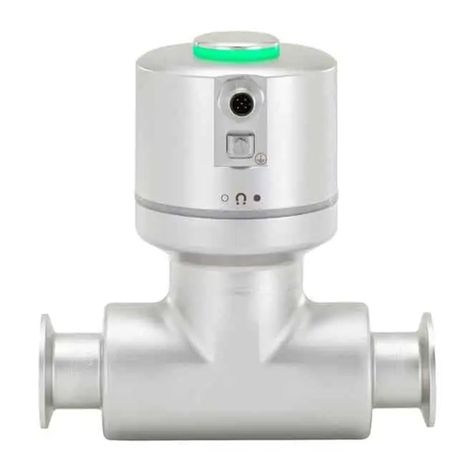
Burkert
Burkert FLOWave S operating instructions
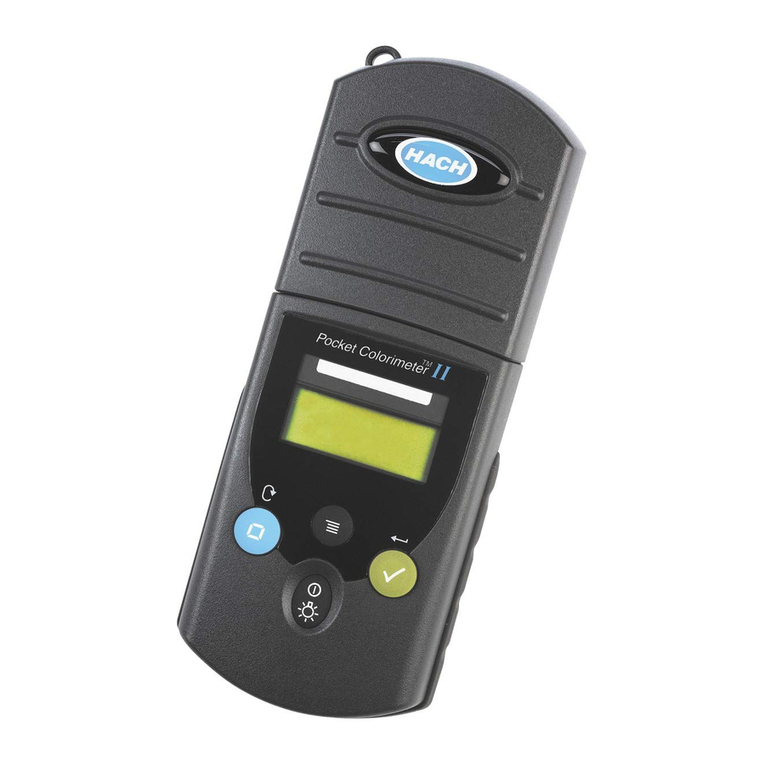
Hach
Hach POCKET COLORIMETER II instruction manual

RS PRO
RS PRO RS-8880 instruction manual
